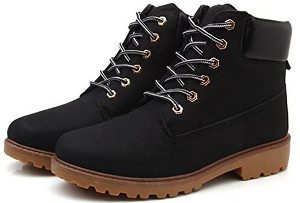This is a treacherous time of year (at least in the Northern Hemisphere — you folks in the Southern Hemisphere can bookmark this and read it again in May or June) with occasional icy conditions on sidewalks.
While it’s best to just stay in your warm, comfy home when it’s icy out, sometimes that is not an option.
Here are some things you can do that will help prevent potentially deadly falls on icy walk-ways.
Walk slowly
This is probably the most important piece of advice in this post: Getting into a hurry on a slippery surface greatly increases your chance of slipping and falling. Walk slowly and take small steps. This is not only applicable for ice, but plain rain can make concrete (or asphalt, or even mud) very slippery. Carefully and slowly shift your weight between feet anytime the walkway isn’t completely dry.
The title on this YouTube video says “funny” but I personally don’t see much humor in it.
Keep your feet about shoulder width apart
If your feet are too close together, that can impair your balance. But don’t spread your legs too far apart — that is just as bad as having them too close together. An inch or two farther apart than shoulder width is about optimal.
Lean slightly forward
It is easier to keep (or recover) your balance if you are leaning just a little forward. That also reduces your chances of falling backward — and hitting your head. If you do fall forward, you have your arms available to break the fall and shield your head. You might hurt your hands or arms, but that’s a lot less deadly than hitting your head on the ice. Even landing on your butt can be very painful. A cracked tailbone is no fun.
Wear appropriate shoes
Smooth-soled leather shoes, or high-heels, might look nice, but being fashionable is not really important when you are walking on ice. A set of good non-slip boots with ankle support can help prevent a fall.
Don’t worry about them being ugly. Being in the hospital with a hip or head injury is much uglier.
Don’t try to carry a bunch of stuff by yourself
If you are leaving a grocery store with your purchases, don’t load them into your arms and try to carry them. Pushing a cart will give you something to hang on to and maintain balance. If that’s not an option, get help from one of the store employees. If you have to carry something, use a backpack. Or better yet, a young, healthy, strong friend or relative. 🙂
Use ice cleats
The above advice on how to walk on ice is useful and will help you if you are caught in that situation, but even better would be having a set of slip-on ice cleats with you. These are fairly inexpensive (especially when compared to a hospital bill), and are small enough to store in a coat pocket or purse. They are easy to slip on when needed, and easy to slip off so you don’t damage indoor flooring when you arrive at your destination.
You should keep a set of these ice cleats handy all winter long.
Remember to keep in mind all of the other tips for walking on ice safely in mind — ice cleats will help, but if you are careless, you can still fall.











